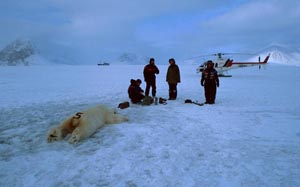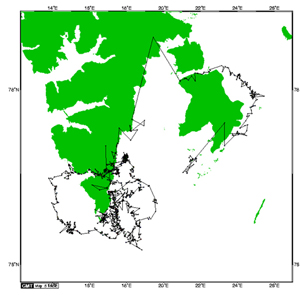Polar bear migration between Hornsund and Storfjorden
By Jørn Henriksen, Øystein Overrein
 Scientists have tranquilized and marked a polar bear in Hornsund. The number on the hindquarters enables identification of the animal from a long distance. The number disappears with wear and tear and moulting. More than 100 polar bears in the Svalbard area carry a satellite transmitter, which aids in determining migration routes and adaptations to changing ice conditions. (Image: Jon Aars / The Norwegian Polar Institute) Scientists have tranquilized and marked a polar bear in Hornsund. The number on the hindquarters enables identification of the animal from a long distance. The number disappears with wear and tear and moulting. More than 100 polar bears in the Svalbard area carry a satellite transmitter, which aids in determining migration routes and adaptations to changing ice conditions. (Image: Jon Aars / The Norwegian Polar Institute)
 This picture shows satellite data from a female polar bear during the summer of 2005. She followed the drift ice around Sørkapp and then she continued into Hornsund. This is a typical migration pattern. (Figure: Jon Aars / Norwegian Polar Institute) (Image: Jon Aars / The Norwegian Polar Institute) This picture shows satellite data from a female polar bear during the summer of 2005. She followed the drift ice around Sørkapp and then she continued into Hornsund. This is a typical migration pattern. (Figure: Jon Aars / Norwegian Polar Institute) (Image: Jon Aars / The Norwegian Polar Institute)
This area is well known for the high density of polar bears. For visitors in boats it is particularly early in the season, when there is still fast ice in Brepollen, that chances are good to get a sight of the King of the Arctic.
Hornsund is a good area for polar bears for a number of reasons, one of the more important being that the ringed seal gives birth on the ice in this area in the spring. Late in the autumn the bears migrate back into Hornsund as the ice forms on the east side of Spitsbergen. Which direction they come from depends on how the ice is formed and how it drifts. There is a relatively high movement of bears in and out of Hornsund. For example, bears can come with the drift ice around Sørkapp and into Hornsund from the west and continue east across Hornbreen and back to the east coast.
Helge Ingstad described this migration in his book “The Land of the Cold Coasts” (1948), based on expert knowledge from trappers of the time. This knowledge holds up when compared to modern telemetrics of the bears’ movement, based on satellite data from transmitters mounted on female bears.
Read more about polar bears
|